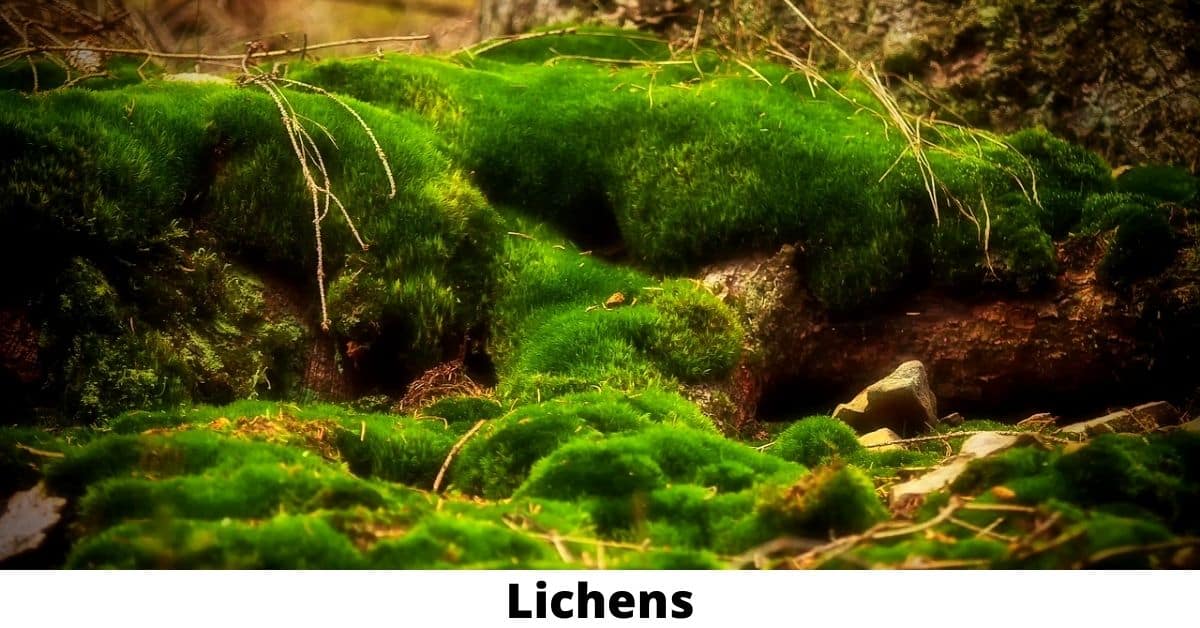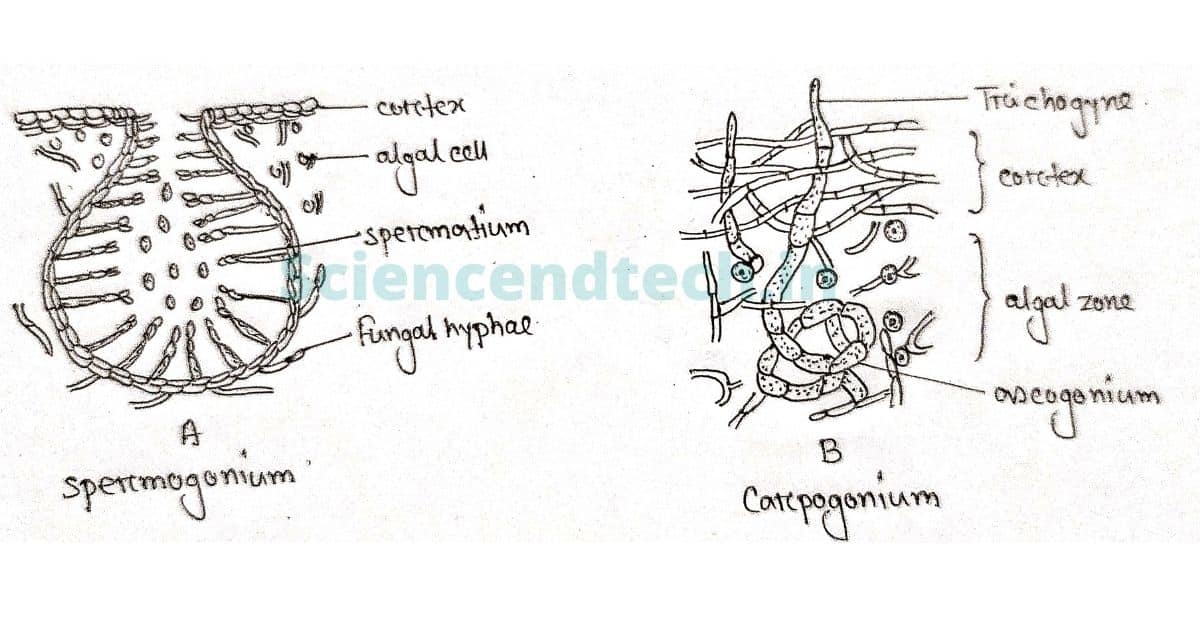Lichens are a small group of plants of composite nature, consisting of two dissimilar organisms, an alga-phycobiont (mykos- fungus, bios- life) and a fungus-mycobiont (mykes-fungus, bios-life), living in a symbiotic association. Generally, fungal partners cover mostly portion and developed their own reproductive structures. Algal partner produced food through photosynthesis.
Important characteristics of Lichens
- Lichens formed by the association of algae and fungi.
- Algal partners produce carbohydrates through photosynthesis and fungal partners serve the function of absorption and retention of water.
- Based on the morphological structure of thalli, they are of 3 types: crustose, foliose, and fruticose.
- Lichens reproduce by 3 proceeds – vegetative, asexual and sexual.
- Growth is very slow, they can survive in adverse conditions with high temperature and dry condition.
Structure of thallus
The plant body is a thalloid with different shapes and colours.
External structure
Hawksworth and Hill (1984) categorised the lichen into five main types:
- Leprose: Where the fungal mycelium envelopes either a single or small cluster of algal cells. The algal cell does not envelope all over by fungal hyphae. The lichen appears as a powdery mass on the substratum. e.g. Lepraria incana.
- Crustose: These are encrusting lichens where thallus is inconspicuous, flat and appears as a thin layer or crust on substratum like barks, stones, rocks etc. e.g. Graphis, Lecanora etc.
- Foliose: These are leaf-like lichens. Some parts attached with the substratum by means of hyphal outgrowth, the rhizines, developed from the lower surface. e.g. Parmelia, Physcia etc.
- Fruticose: These are shrubby lichens, where thalli are well developed, cylindrical branched, shrub-like, either grow erect or hang from the substratum by a basal disc. e.g. Cladonia, Usnea etc.
- Filamentous: In this type, algal members are filamentous and we’ll develop. The algal filaments remain ensheathed by only a few fungal hyphae. e.g. Racodium, Ephebe etc.
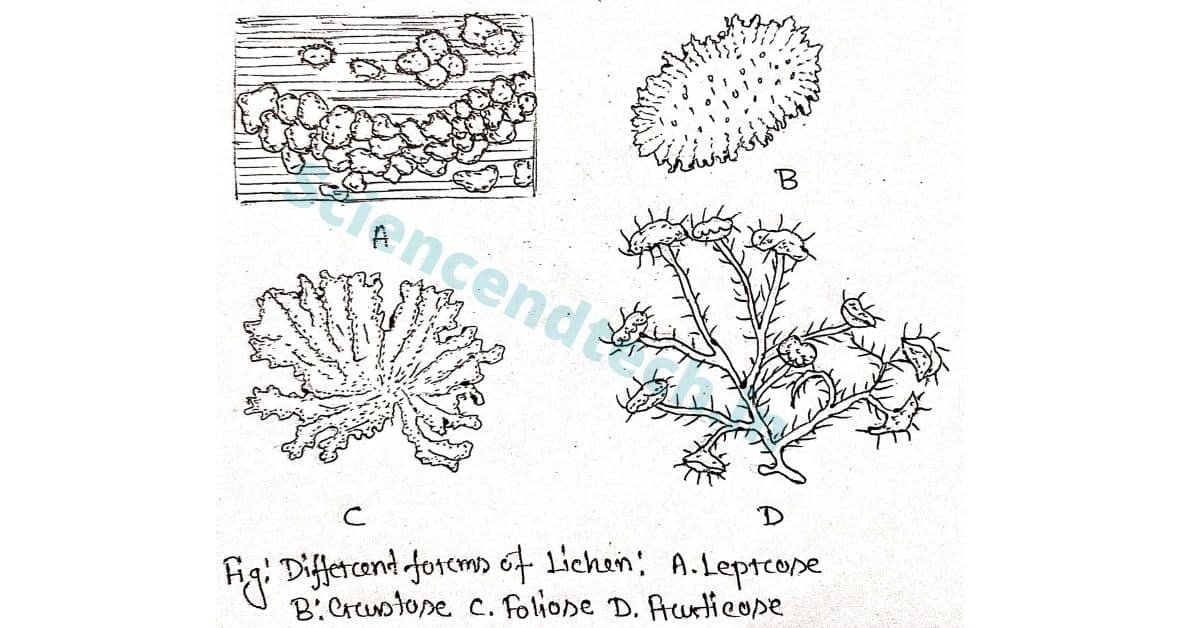
Internal structure
- Homoiomerous: Here the fungal hyphae and algal cells are more or less uniformly distributed throughout the thallus. Both the partners intermingle and form a thin outer protective layer. e.g. Leptogium, Collema etc.
- Heteromerous: Thallus is differentiated into four distinct layers:
- Upper cortex: Outermost protective covering, compactly arranged interwoven fungal hyphae.
- Algal zone: below the upper cortex here algal cells are entangled by the loosely interwoven fungal hyphae.
- Medulla: just below the algal zone, composed of loosely interwoven thick-walled fungal hyphae with large space between them.
- Lower Cortex: lowermost layer composed of compactly arranged hyphae, which may arrange perpendicularly to the surface. Some of the hyphae may extend downwards and penetrate the substratum which helps in Anchor, known as rhizines.
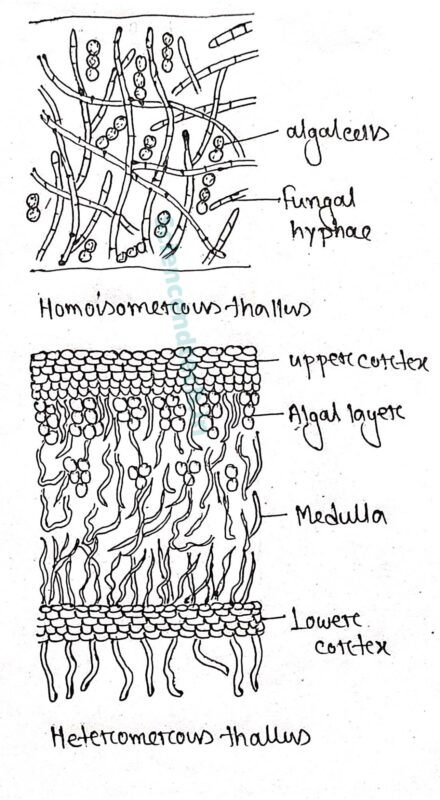
Reproduction
Lichens reproduce by all three means, vegetative, asexual and sexual.
1.Vegetative reproduction:
- Fragmentation: It takes place by accidental injury where the thallus may be broken into fragments and each part is capable of growing normally into a thallus.
- Death of older parts: The older region of the basal parts dies, causing separation of some lobes or branches and each one grows normally into a new thallus.
2. Asexual reproduction:
- Soredium: These are small greyish-white, bud-like outgrowths developed on the upper cortex of the thallus. They are detached from the thallus by rain or wind and on germination, they develop new thalli. e.g. Parmelia, Physcia etc.
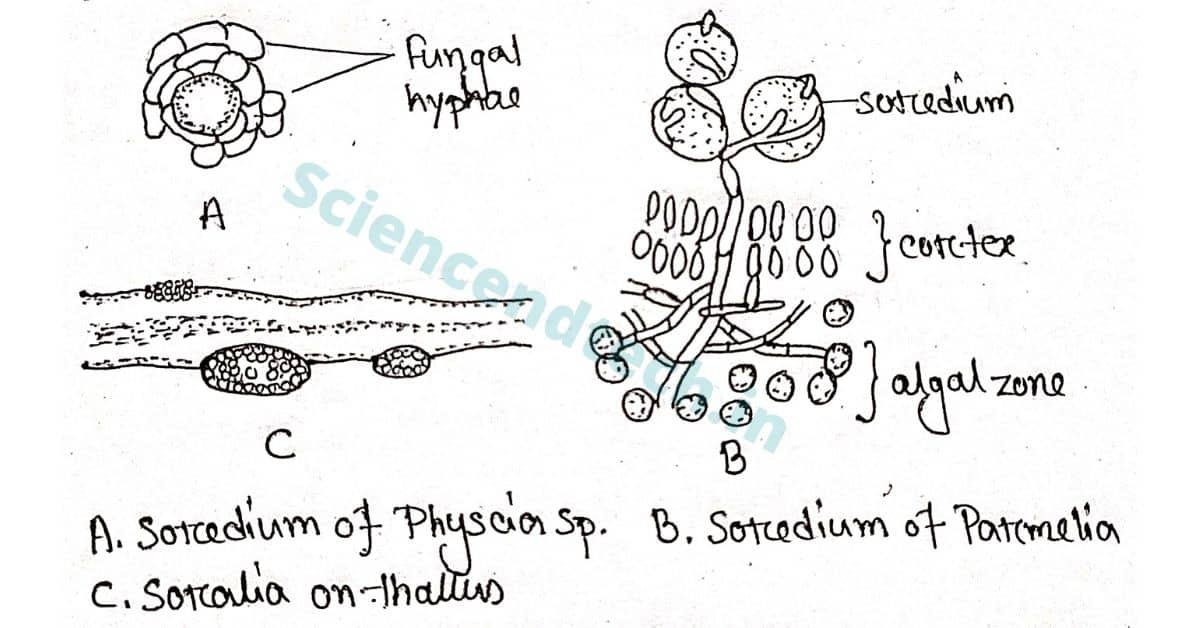
- Isidium: The isidium has an outer cortical layer continuous with the upper cortex of the mother thallus which encloses the same algal and fungal elements as the mother which is detached very easily from the parent thallus. Under favourable conditions, the isidium germinates and gives rise to a new thallus.
- Pycniospore: some lichen developsevelop pycniospores or spermatium inside the flask-shaped pycnidium. They usually behave as gametes. Under the favourable condition, they germinate and develop fungal hyphae.
3. Sexual reproduction:
The fungal partner of the lichen reproduces sexually and forms fruit bodies. Sexual reproduction in Ascolichen is the members of Ascomycota, whereas in Basidiolichen is like that of Basidiomycotina members.
In Ascolichen, the female sex organ named as carpogonium and the male sex organ , as spermogonium. Multicellular carpogonium is differentiated into basal coiled ascogonium and upper elongated multicellular trichogyne. The ascogonium remains embedded in the algal zone.
The spermatogonium is flask-shaped and develops spermatia from the inner layer. The spermatia behave as male gametes. The spermatium, after liberating from spermatogonia, gets attached with the trichogyne at the sticky projected part. The nucleus of spermatium migrates into the carpogonium and fuses with the egg when the common wall dissolved.
In Basidiolichen, the result of sexual reproduction is the formation of basidiospores that develop on basidium as in typical Basidiomycotina. The fungal member along with the blue-green alga, as an algal partner, forms the thalloid plant body. The thallus grown over soil produces hypothallus without rhizines, but on tree trunks, it grows like bracket fungi and differentiated internally into the upper cortex, algal layer, medulla and lower fertile region with basidium bearing basidiospores.
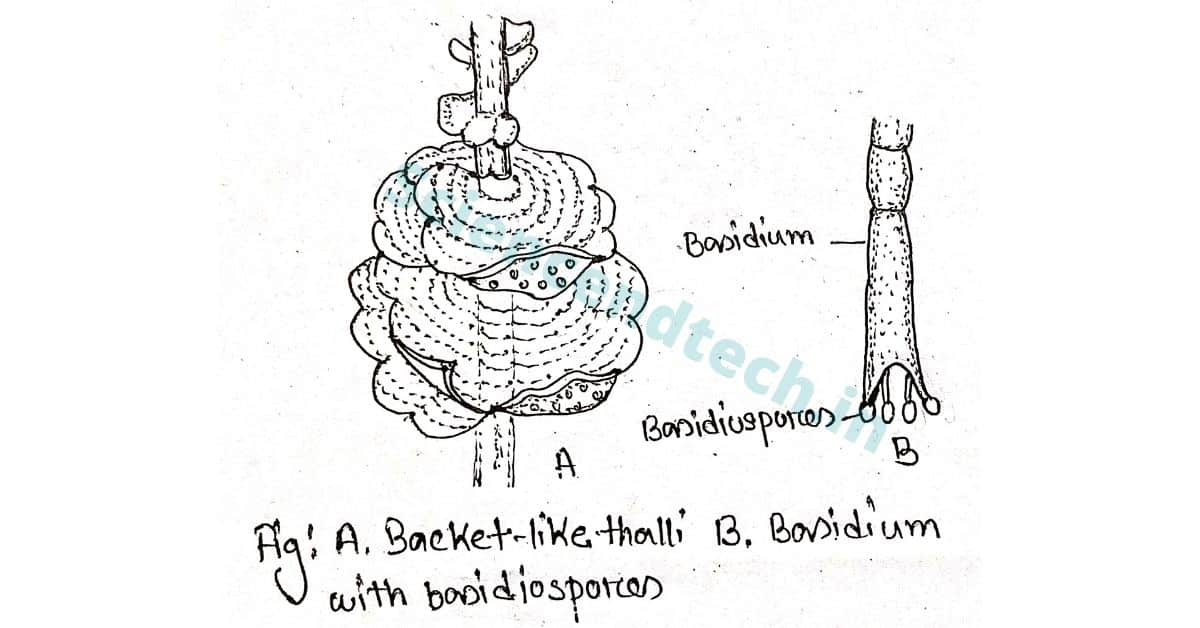
Many ascogenous hyphae develop from fertilised ascogonium. The binucleate penultimate cell develops into an ascus. Both the nuclei fuse and form a diploid nucleus (2n), which undergoes first meiotic and then mitotic division – results in eight haploid daughter nuclei. Each haploid nucleus with some cytoplasm metamorphoses.
The asci remain intermingled with paraphyses (sterile hyphae). Then asci and paraphyses become surrounded by vegetative mycelium and form a fruit body. This type may be asco hymenial type or apothecium as in Parmelia, Anaptychia or perithecium as in Verrucaria. Apothecium consists of three distinct parts, the middle thecium, consisting of asci and paraphyses, is the fertile zone covered by two sterile zones- the upper epitheca and lower hypotheca. This region differentiated like the vegetative thallus into the outer cortex, algal zone and central medulla.
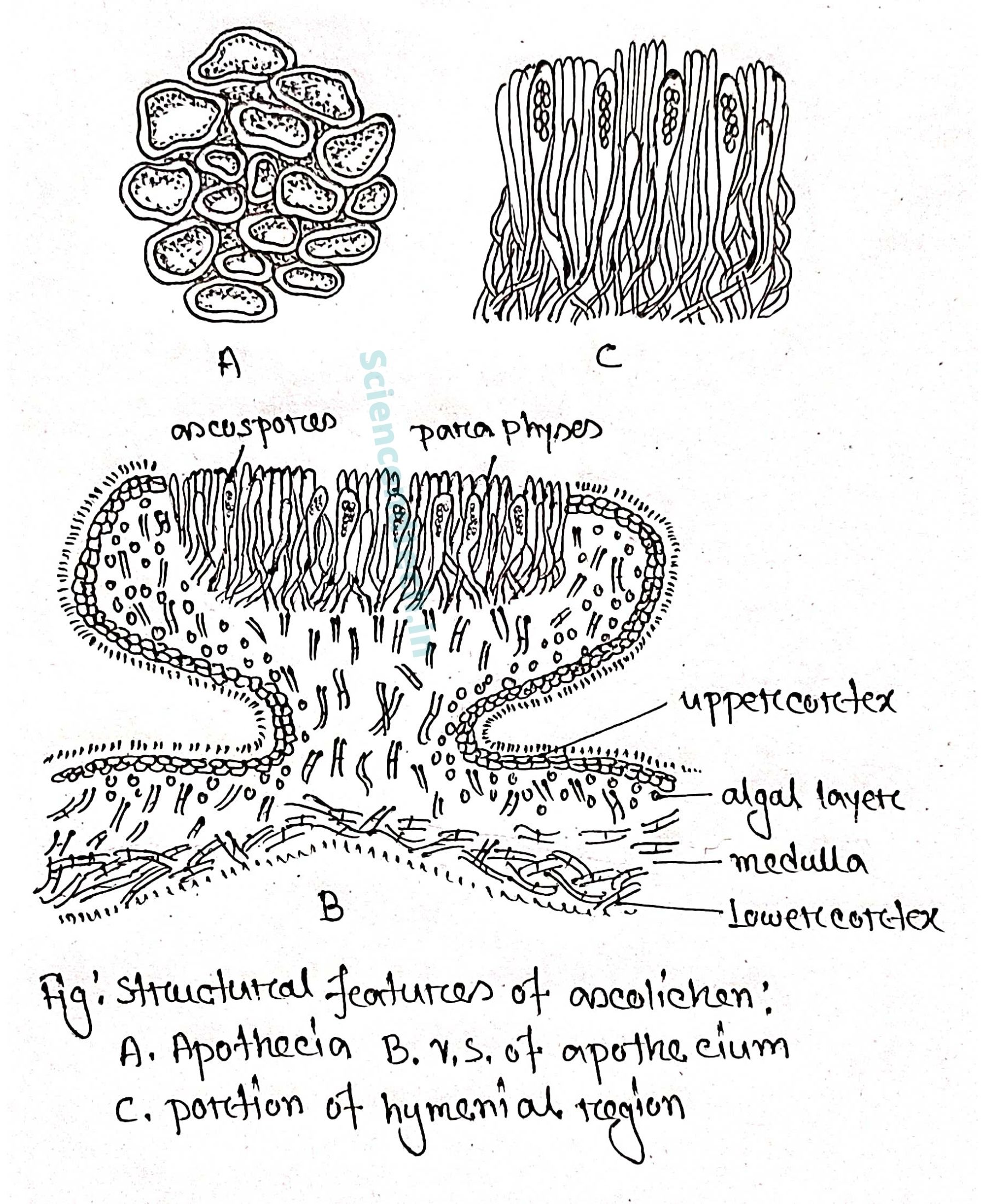
Importance
- some species of Parmelia are used as curry powder in India, Endocarpon miniatum used as vegetables all over the world.
- Ramalina fraxinea, R. fastigiata are used as fodder for animals, due to the presence of lichens, a polysaccharide.
- Some lichens are used as important ingredients of many antiseptic creams, because of their spasmolytic and tumour-inhibiting properties.
- Litmus, an acid-base indicator dye, is extracted from Roccella tinctoria, R. Montagnei and also from Lasallia pustulata.
- Lichens like Letharia vulpina (wolf moss) are highly poisonous.
- Lichens are very much sensitive to air pollutants like So2, CO, CO2 etc. thereby the number of lichen thalli in the polluted area is gradually reduced and ultimately comes down to nil, called ‘Pollution indicators’.
That’s it for this post. If you have any query please feel free to comment below. Thank you.
What are lichens?
Lichens are a small group of plants of composite nature, consisting of two dissimilar organisms, an alga-phycobiont (mykos- fungus, bios- life) and a fungus-mycobiont (mykes-fungus, bios-life), living in a symbiotic association.
How many methods of reproduction are there for Lichens?
They reproduce by all three means, vegetative, asexual and sexual.
What is Soredium?
These are small greyish-white, bud-like outgrowths developed on the upper cortex of the thallus.
What is Pycniospore?
some lichen developsevelop pycniospores or spermatium inside the flask-shaped pycnidium. They usually behave as gametes. Under the favourable condition, they germinate and develop fungal hyphae.

